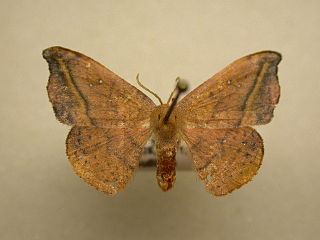
Rhizedra lutosa, the large wainscot or Isle of Wight wainscot, is a species of moth of the family Noctuidae. It is native to the Palearctic ecozone. It has been introduced into eastern North America and is spreading.
Oreta is a genus of moths belonging to the subfamily Drepaninae. The genus was erected by Francis Walker in 1855.

Andriasa contraria is a moth of the family Sphingidae. It is known from tropical Africa, including Kenya, Cameroon and South Africa. It is a very variable species and is common in all habitats except deserts and high mountains.

Oreta extensa is a species of moth of the family Drepanidae described by Francis Walker in 1855. It is found in China, Taiwan, India, Sri Lanka, Indonesia and Thailand.
Oreta carnea is a moth in the family Drepanidae. It was described by Arthur Gardiner Butler in 1892. It is found in Malaysia, Singapore and on Sumatra, Java and Borneo.
Oreta paki is a moth in the family Drepanidae. It was described by Hiroshi Inoue in 1964. It is found in Korea, China and the Russian Far East.

Oreta rosea, the rose hooktip moth, is a moth in the family Drepanidae. It was described by Francis Walker in 1855. It is found in North America, where it has been recorded across boreal Canada to eastern North America. In the north, the range extends to northern Alberta, northern Manitoba and Newfoundland. It is also found east of the Great Plains as far south as Florida and eastern Texas. The habitat consists of moist temperate hardwood forests.
Oreta shania is a moth in the family Drepanidae. It was described by Watson in 1967. It is found in China.
Oreta trispina is a moth in the family Drepanidae. It was described by Watson in 1967. It is found in China.
Oreta obtusa is a moth in the family Drepanidae. It was described by Francis Walker in 1855. It is found in India, China, Myanmar and Indonesia.
Oreta bicolor is a moth in the family Drepanidae. It was described by William Warren in 1897. It is found in Sundaland and Malaysia.
Oreta singapura is a moth in the family Drepanidae. It was described by Charles Swinhoe in 1892. It is found in Singapore, Malaysia, Indonesia and New Guinea.
Oreta subvinosa is a moth in the family Drepanidae. It was described by William Warren in 1903. It is found in New Guinea, where it is known from Papua.
Oreta unilinea is a moth in the family Drepanidae. It was described by William Warren in 1899. It is found in New Guinea, where it is known from Papua and Roon Island.
Oreta rubromarginata is a moth in the family Drepanidae. It was described by Charles Swinhoe in 1902. It is found on Borneo and Sumatra.
Negera confusa is a moth in the family Drepanidae. It was described by Francis Walker in 1855. It is found in Cameroon, Ghana, Ivory Coast, Nigeria, Sierra Leone and the Gambia.
Eupterote plumipes is a moth in the family Eupterotidae. It was described by Francis Walker in 1855. It is found in Sri Lanka.
Poloma angulata is a moth in the family Eupterotidae. It was described by Francis Walker in 1855. It is found in South Africa.
Eupterote pallida is a moth in the family Eupterotidae. It was described by Francis Walker in 1855. It is found in India.
Laelia suffusa is a moth of the family Erebidae first described by George Hampson in 1893. It is found in Bangladesh, Sri Lanka, Java, East Indies, Sundaland, the Philippines and Sulawesi.



